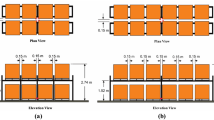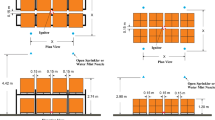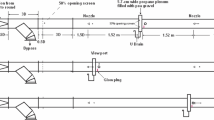Abstract
An investigation was conducted to determine the feasibility of extending the total flooding water mist protection previously developed for a 7.47 × 7.47 × 7.47-m3 ignitable liquid dispensing facility to a larger building, for a longer but acceptable fire extinguishing time. The targeted building height and door opening were 7.62 m and 3.81 × 3.81 m2, respectively. Same as for the 7.47-m cubic facility, the fire challenge was the combination of a cascading heptane fire spilling from the top of a fuel tank and the resulting shielded pool fire on the floor. The Froude-based scaling methodology and a well-stirred reactor model were used to assess the maximum building size and associated water mist requirement for a 0.48-scale mockup of the 7.62-m high facility, under the constraint of meeting the designated fire extinguishment time. A series of fire tests was then conducted in the 0.48-scale mockup to verify that the fire could indeed be extinguished within the designated duration for the determined building size and protection requirement. In general, it took less time to extinguish the fire as the water mist discharge rate was increased. The water mist sprays deployed in the door opening tended to reduce the fire extinguishment time by reducing air flow through the door opening, but not significantly in this investigation. However, the deployment of water mist sprays in the door opening is highly recommended to confine the spill fire within the protected building. The tests also showed that it took longer time to extinguish the fire as the fire was closer to the door opening. Based on the 0.48-scale test results and scaling relationships, the water mist protection requirement and corresponding fire extinguishment time for the 7.62-m high facility were projected for a building floor area of 580 m2.









Similar content being viewed by others
References
Yu H-Z (2013) Physical scaling of water mist protection for ignitable liquid cut-off rooms. J Fire Prot Eng 23(3):157–176
Yu H-Z (2012) Froude-modeling-based general scaling relationships for fire suppression by water sprays. Fire Saf J 47:1–7
Yu H-Z (2011) Physical scaling of water mist suppression of pool fires in enclosures. In: Proceedings of the 10th international symposium on fire safety science, International Association of Fire Safety Science, pp 19–24
Yu H-Z, Kasiski R, Daelhousen M (2015) Characterization of twin-fluid (water mist and inert gas) fire extinguishing systems by testing and modeling. Fire Technol 51:923–950. doi:10.1007/s10694-014-0428-z
Zabetakis M (1965) Flammability Characteristics of Combustible Gases and Vapors. Bulletin 627, U.S. Department of the Interior, Bureau of Mines
Roberts AF, Quince BW (1973) A limiting condition for the burning of flammable liquids. Combust Flame 20:245–251
Macek A (1979) Flammability limits: a re-examination. Combust Sci Technol 21:43–52
Pitts WM (2009) Improved understanding of thermal agent fire suppression mechanisms from detailed chemical kinetic modeling with idealized surrogate agents, In: Proceedings of the 32nd symposium (international) on combustion, The Combustion Institute, pp 2599–2606
Foster AM, Swain MJ, Barrett R, D’Agaro P, James SJ (2006) Effectiveness and optimum jet velocity for a plane jet air curtain used to restrict cold room infiltration. Int J Refrig 29:692–699
Lefebvre AH (1989) Atomization and spray. Hemisphere Publishing Corporation, New York
ASME (2007) ASME boiler & pressure vessel code—II Part D: properties (customary) materials, The American Society of Mechanical Engineers, New York
Author information
Authors and Affiliations
Corresponding author
Rights and permissions
About this article
Cite this article
Yu, HZ. Investigation of Fire Extinguishment in Large Facilities based on Physical Scaling, Modeling and Testing. Fire Technol 52, 2143–2157 (2016). https://doi.org/10.1007/s10694-015-0546-2
Received:
Accepted:
Published:
Issue Date:
DOI: https://doi.org/10.1007/s10694-015-0546-2




